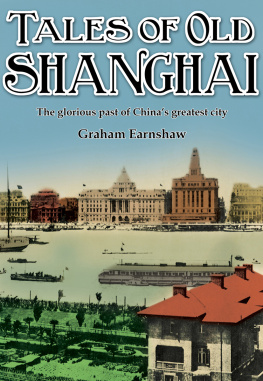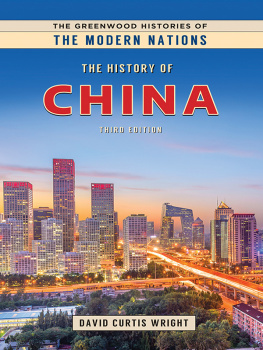ABOUT THE AUTHOR
Graham Earnshaw was born in England and has lived most of his adult life in the China world. He speaks Cantonese and Mandarin and his translation of the Jin Yong kung fu novel The Book and The Sword into English was published in 2004 by Oxford University Press. He has been a journalist, writer and publisher. Other books he has written include Life and Death of a Dotcom in China, published in 2000, and Tales of Old Shanghai, published in 2008.
To the people of China, who have taught me so much.
The Great Walk of China
eBook ISBN 978-988-19003-5-7
Published by Blacksmith Books
5th Floor, 24 Hollywood Road, Central, Hong Kong
Tel: (+852) 2877 7899
www.blacksmithbooks.com
Copyright Graham Earnshaw 2010
The author asserts the moral right to
be identified as the author of this work.
All rights reserved. No part of this publication
may be reproduced, stored or transmitted in any
form or by any means, electronic, mechanical,
photocopying, recording or otherwise, without
the prior written permission of the publisher.
PREFACE
THE FIRST STEP
I am walking from Shanghai to Tibet.
It is a great line, and it is true. My journey is not continuous; I walk when I have the time, usually once a month and always starting from the last place I stopped and always heading west. With every step, I cover an unbroken trail that began at the Bund in the heart of Shanghai, to (as I write this in January of 2010) the Sichuan basin north of Chongqing.
I have walked, with many twists and turns, well over two thousand kilometres since I began this venture in 2004, having passed through two municipalities (Shanghai and Chongqing), five provinces (Jiangsu, Zhejiang, Anhui, Hubei and Sichuan) and countless towns and villages.
People often ask me how I came up with the concept of a walk across China, and my thanks go to Edwin Dingle for being my inspiration. In the late spring of 2004, I was sitting in a Japanese restaurant in Shanghai and reading Dingles book Across China on Foot, which tells the tale of the Englishmans 1909 trek. But Dingle didnt really cross China on foot; instead, he took boats up the Yangtze River from Shanghai to Chungking (now spelled Chongqing) and then, over a period of nine months, walked southwest through Sichuan and Yunnan provinces to the Burmese border. The twenty-eight-year-old Dingle could neither speak nor read Chinese, so while the book is highly readable and fascinating in its descriptions of magnificent scenery, hotel squalor and the activities of foreign missionaries, it lacks a certain local depth.
As I feasted as usual on salmon sashimi and cucumber sticks, I thought to myself: I can do better than that, and over another flask of hot sake I mapped out the plan. I would walk due west from Shanghai towards Lhasa, staying as close as possible to the 31st parallel Shanghai is at thirty-one degrees north, which is the same latitude as Marrakesh, Morocco. The Yangtze Gorges are at thirty degrees north, while Lhasa is at twenty-nine degrees, making the journey pretty much a straight line due west for four thousand kilometres. The expedition would have to be non-contiguous, because I lead a busy life, but the rule would be to always start from the last place I stopped, so that I would literally walk every step of the way.
The decision was made: I would walk to Tibet. I pushed my empty plates aside, turned on my laptop and opened up Microsoft Encarta (this was in the days before Google Earth). Looking at the vast map of China, my first question as I looked west of Shanghai was whether I should go north or south of Tai Hu, the almost perfectly circular lake about fifty kilometres from the city. North would take me through Suzhou, Changzhou, Wuxi and Nanjing, tracking close to the lower reaches of the Yangtze River. This route wanders through towns and cities that are well-known, well-travelled and well-integrated into the global economy, thanks to their export industries. Travelling to the south of the lake would take me through Pingwang, Huzhou, Changxing and Guangde: towns and cities I had never even heard of and knew nothing about. It was an easy choice; I would take the southern route.
I started the walk the very next afternoon: April 4, 2004. It was a bright and shiny late spring day. As I walked those first few kilometres, I wondered many times if I could really do it and whether the goal of walking across China was, pardon the pun, really a step too far.
But I persevered and, after a few months, I became proud of the distance I had put between myself and Chinas largest city. For a long time I didnt tell anyone of my plan because I was worried that I would fail. Then, somewhere in the rice paddies of Zhejiang Province, I decided the dream could become a reality and I became for many people, including myself, the man who is walking across China.
As I walk, I am constantly reminded of the many reasons I decided to do this.
I bill myself as a China expert, and while I have set foot in every province and region of China at one time or another over the thirty years I have lived in and around this country, there are vast areas that I have never seen. The walk gives me some credibility to speak to the Real China, in a way that is at least closer to the truth than the view from central Beijing or downtown Shanghai.
I have always been interested in how China and the West interact, in all ways. Just about everything I have done seems to have been an exploration of how these two cultures fit together and for me, it is an unending investigation. The walk yields an interesting perspective on China/Outside dynamics because for just about everyone I meet out there, I am the first non-Chinese person they have ever seen, let alone spoken to. The fact that, unlike Mr. Dingle, I can also read and speak Chinese means that I can talk to people and I can read the signs and slogans and graffiti that I come across. I see things in a way that many non-Chinese would not, and perhaps in a way that many Chinese would miss because I have an outsiders perspective.
When I first came to Mainland China in 1978, this was a very closed country. Foreigners were not allowed to travel beyond a radius of about twenty kilometres from the centre of Beijing without official approval from the Foreign Ministry. Every road out of Beijing had a sign posted and a checkpoint that required foreigners to stop and turn back if they lacked a pass to proceed. My walk is a way to test todays limits, of proving how much China has changed and how much it has opened up to the world. It is, hopefully, a celebration of tolerance.
I have a problem with my leg. I limp, and have done so since I underwent an operation at the age of eleven to cut out a section of bone in my right hip joint that had been affected by tuberculosis. This, and later operations, resulted in my right leg being shorter than the left, leaving me with a lop-sided gait and an increasing stiffness of my spine. The walk is partly a message to heaven, declining to accept the afflictions constraints.
I suppose I am also a part of the tradition of English eccentricity, which is particularly strong in Englishmen resident in foreign parts, and often includes the habit of taking long walks. There is no point fighting this kind of thing.












